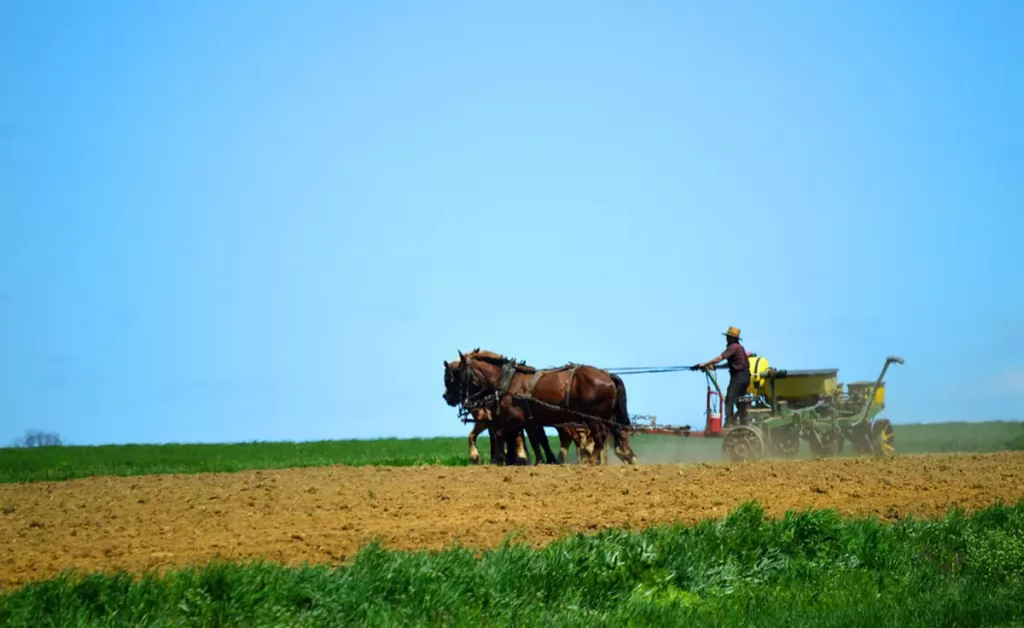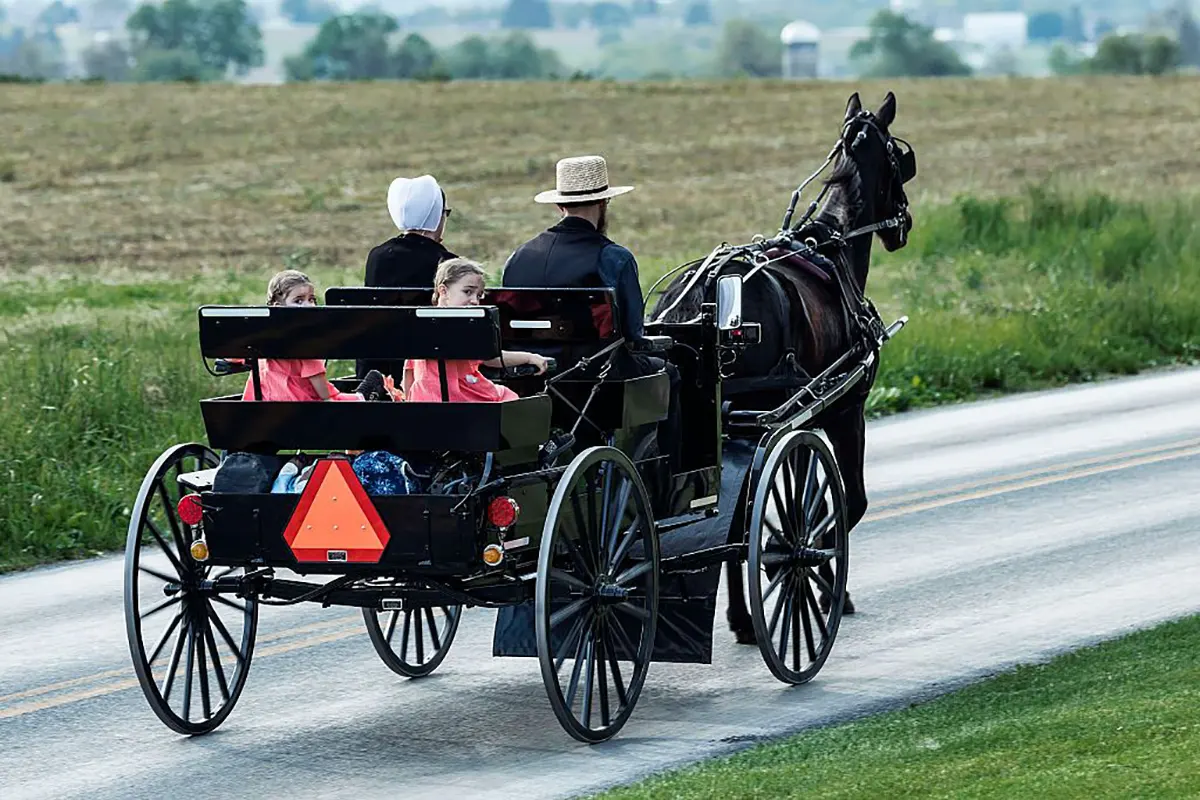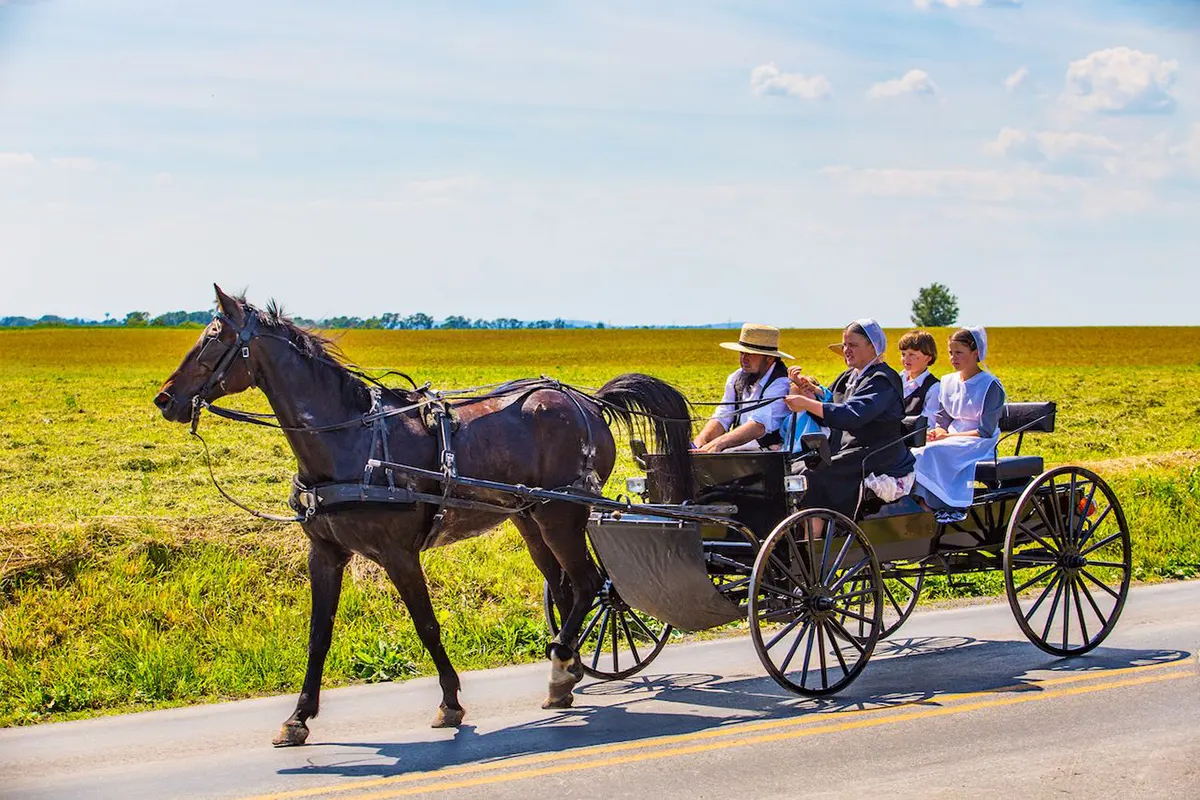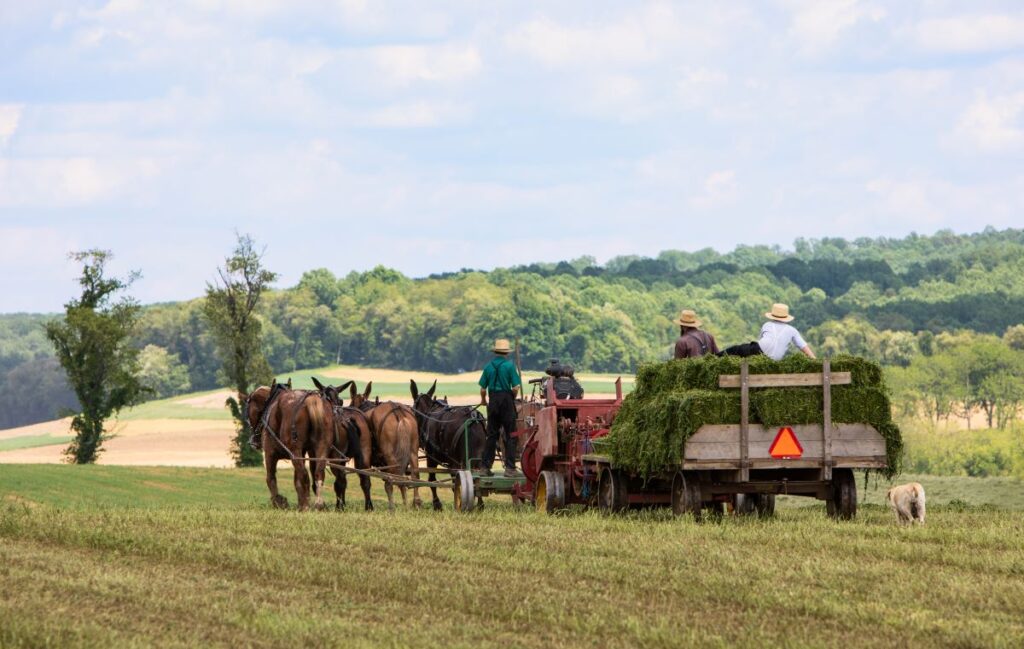The Amish culture is known for its off grid and sustainable way of living developed and passed down over centuries. Living in harmony with nature and valuing the community’s well-being, the Amish lifestyle is based on simplicity, frugality, and self-sufficiency.
The Amish have developed a sustainable lifestyle based on Amish beliefs and faith in God and respect for the environment. They farm via small-scale agriculture, avoid modern conveniences, use transportation without leaving carbon footprints, and reduce waste through natural ways.
In this article, we will explore the sustainable practices of the Amish culture and understand how the Amish way of living can provide a model for sustainable living for the wider society or the rest of the non-Amish world.
Amish Farmers on Agriculture

Every Amish man relies on small-scale and traditional farming methods prioritizing sustainability and soil conservation.
An Amish farm is typically less than 100 acres and often work by hand or with horse-drawn equipment.
One of the critical elements of Amish farming is their commitment to sustainable agriculture, which aims to preserve the land for future generations.
They have developed a way of farming that respects the environment and ensures the long-term viability of the land by avoiding modern farming practices that rely on synthetic inputs and heavy machinery.
While Amish farming practices are similar to organic farming in some ways, they are not necessarily the same, contrary to what many believe.
Organic farming is a regulated industry that adheres to specific standards, while Amish farming practices are based on their cultural traditions and values.
While some would consider their approach “organic farming,” it’s generally better to stick to the “sustainable” term.
Here are some sustainable farming practices that many Amish groups still use today:
- Crop rotation is an essential practice in Amish farming, and it involves planting different crops in the same field in alternating years. It helps to replenish and maintain the soil’s nutrients, prevent soil erosion and reduce pests and diseases.
The Amish plan their crop rotation for several years to ensure the soil remains healthy and balanced.
The crops that should be planted in each field depend on their nutrient requirements; some crops may add nutrients to the ground while others may take them away.
Once the crops are chosen, the Amish farmer alternates the crops from year to year to prevent soil depletion and promote healthy soil.

During fallow, farmers often plant cover crops like rye or clover to protect the soil from erosion, add nutrients, and prevent weeds, bacteria, and pests from building up.
- The Amish farmers rely on natural fertilizers to enrich the soil and promote healthy crop growth. Their choice of preventing chemical fertilizers reduces the risk of environmental damage, ensuring the long-term viability of their farms.
Some common natural fertilizers the Amish use are homemade compost (decomposed manure, food scraps, and yard waste), animal manure, cover crops (clover or rye), ground animal bones, and fish emulsion.
- The Amish practice pest control in various ways, focusing on natural and non-toxic methods that minimize environmental and human health harm.
Some of the Amish’s first steps in preventing pests in their farms are crop rotation, companion planting, setting up traps for rodents, handpicking of beneficial insects like ladybugs or praying mantises, etc.
When there’s already a pest infestation, they use natural pesticides derived from plants or minerals. Some examples of these natural pesticides are Pyrethrin, Neem Oil, Diatomaceous Earth, Garlic Spray, and Soap Spray.
- The Amish people have a strong tradition of manual labor in farming, relying on hand tools and physical work instead of machines.
Instead of using a tractor, the Amish use a horse-drawn-plow or a hand-held hoe to till the soil. It allows them to cultivate the soil more carefully and avoid soil compaction.
They often use hand tools, such as a hoe or a dibber, to plant seeds. It allows them to control the depth and spacing of the future roots more precisely.
When weeding, Amish often use hand-held tools, such as a hoe or a hand cultivator, to remove weeds from the soil. They use a sickle or a scythe to help them harvest crops manually.
- The Amish have a long-standing practice of seed-saving and preserving heirloom seeds, which are open-pollinated varieties passed down from generation to generation.
They carefully select seeds from the healthiest and most productive plants, ensuring they are of the highest quality.
After harvesting, they allow the seeds to dry thoroughly before storing them. It helps to prevent mold and mildew from developing and prolongs their life.
They store them in a cool, dry place like a root cellar or a cool basement.
They often use glass jars or paper envelopes to keep the seeds and label them carefully to ensure they know the variety and year the seeds were saved.
All Amish Communities on Energy
The Amish people avoid using modern technology, such as electricity, which reduces their energy consumption and carbon footprint.

Here are some ways that the Amish have become sustainable in avoiding electricity:
1. The Amish people rely on natural light for illumination, often positioning their homes and buildings to take advantage of the amount of sunlight that enters the area. They also use windows and skylights to allow light to penetrate deep into the building.
2. Instead of electric lighting, the Amish often use gas or oil lamps or kerosene lanterns for illumination. These light sources are not dependent on electricity and are relatively inexpensive.
3. The Amish often use wood stoves or other forms of non-electric appliances, such as hand-cranked washing machines, to perform daily tasks. These appliances are powered by human or animal energy and do not require electricity.
4. The Amish often rely on their community for support, sharing resources and knowledge to live sustainably without electricity. For example, they may share a phone line or a generator to power essential equipment.
Amish People on Transportation
The Amish have a unique transportation approach based on simplicity and sustainability. Here are some ways that the Amish are considered sustainable in regard to their chosen methods of transportation:
Horse and Buggy

The most common transportation for the Amish is a horse-drawn buggy. It allows them to travel relatively long distances without using fossil fuels and promotes a slower pace of living.
Bicycle
Some Amish communities also use bicycles as a form of transportation. It is a sustainable and healthy way to travel short distances.
Carpooling
When traveling long distances, the Amish often carpool with community members, sharing a ride to lessen motor vehicles on the road and minimize their carbon footprint.
Walking
For short trips within their community, the Amish often choose to walk, a sustainable and healthy way to travel.
Minimal Use of Motor Vehicles
While some Amish communities allow motor vehicles, they are typically used only for essential tasks such as medical emergencies, transporting goods, or even important field trips.
They avoid using motor vehicles for everyday transportation as much as possible.
Every Amish Community on Waste Reduction
The Amish value frugality and avoid waste by repairing and reusing items rather than throwing them away.

They reduce their environmental impact and promote a sustainable way of life by composting, recycling, minimizing packaging waste, reusing and repurposing items, and setting up community recycling centers.
Many Amish people also practice recycling, separating materials like glass, metal, and paper to be recycled rather than thrown away.
They are known for resourcefulness and often find creative ways to reuse and repurpose items. For example, they may turn old clothing into rags or quilts or use scrap wood to build furniture or structures.
Some Amish settlements, especially those in Lancaster County in Pennsylvania, have set up recycling centers where they can bring their recyclable materials and sort them for proper disposal.
The Amish Way of Sharing Resources Within the Community

The Amish embrace community and work together to support each other.
As an essential aspect of their sustainable lifestyle, people within each Amish community regularly share resources such as tools and equipment, reducing the need to buy and own individual items.
Here are some samples of them sharing resources among the community members that have already become a regular part of the Amish life and traditional practices:
1. One of the most well-known customs of the Amish community sharing is the tradition of barn raising.
When a community member needs a new barn or other structure, everyone comes together to help build it. This Amish tradition not only saves money and resources but also strengthens the bonds of the group.
2. The Amish often share tools and equipment among community members. For example, if someone needs to borrow a tractor, they can ask a neighbor rather than purchasing their own.
It reduces the number of items that need to be bought and maintained and promotes a culture of sharing and cooperation.
3. The Amish often share traditional food and recipes within the community. For instance, if one Amish family has a surplus of vegetables from their garden, they may share them with their neighbors rather than letting them go to waste.
This practice reduces food waste and helps ensure that every Amish home has access to fresh and healthy food.
4. The Amish often share childcare responsibilities among Amish children. For example, if one family needs to go out of town, they may ask a neighbor to watch their children.
Aside from reducing the need to pay for childcare services, it also helps Amish children bond with their neighbors and expose them to the rest of the community.

The Amish life provides a fascinating example of sustainability in action. Their commitment to simplicity, community, and resourcefulness within their respective Amish community has allowed them to thrive for centuries without degrading the natural world or compromising their values..
From their approach to waste reduction and resource sharing to their reliance on horse-drawn transportation, the Amish offer valuable lessons for anyone, even a non-Amish man, seeking a more sustainable and fulfilling life.
The Amish demonstrate that a more straightforward, more connected way of life can be rewarding and sustainable for individuals, communities, and the planet Earth.
